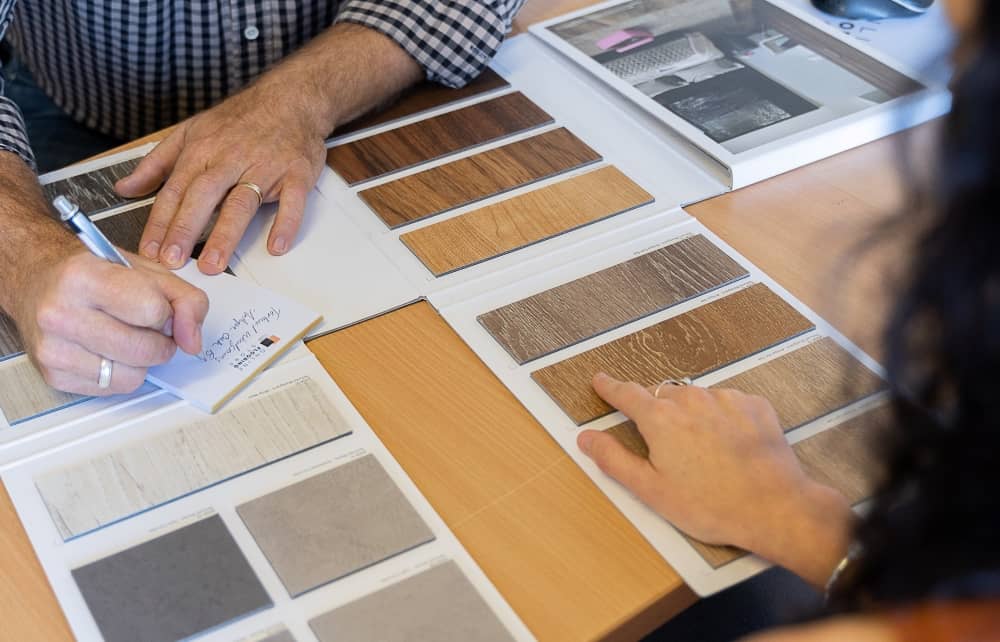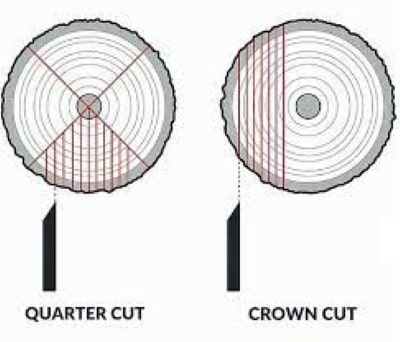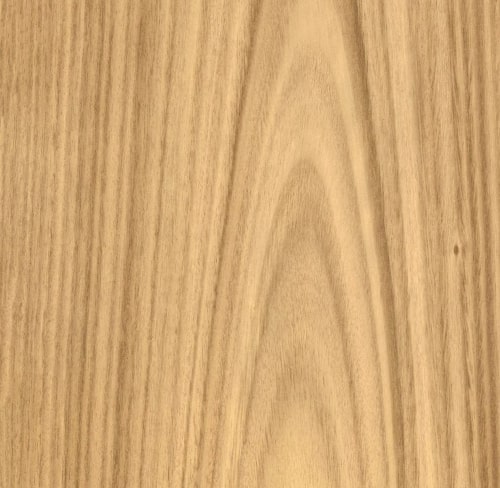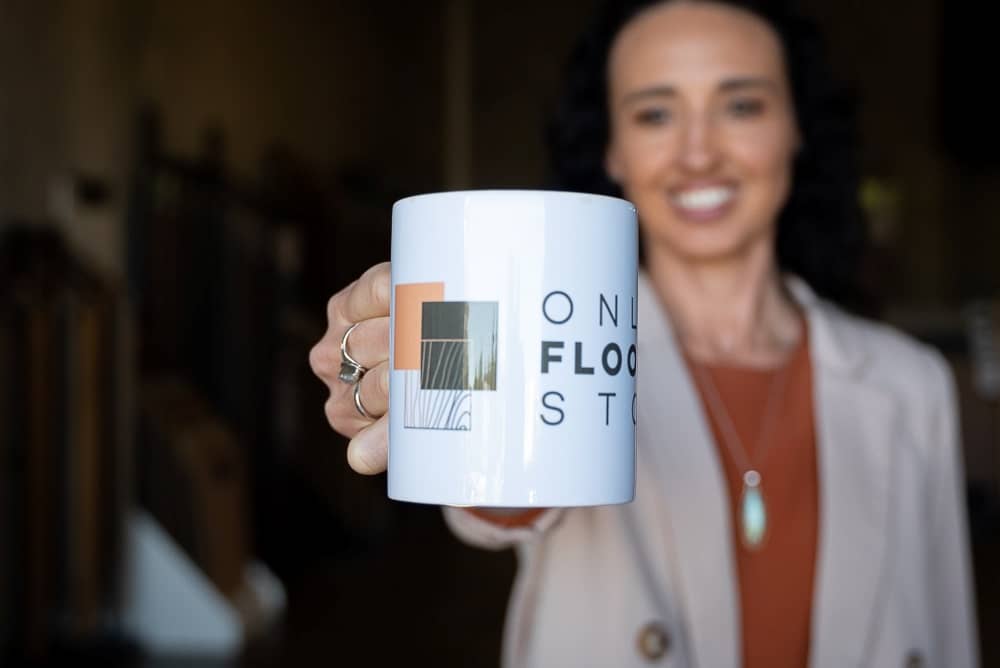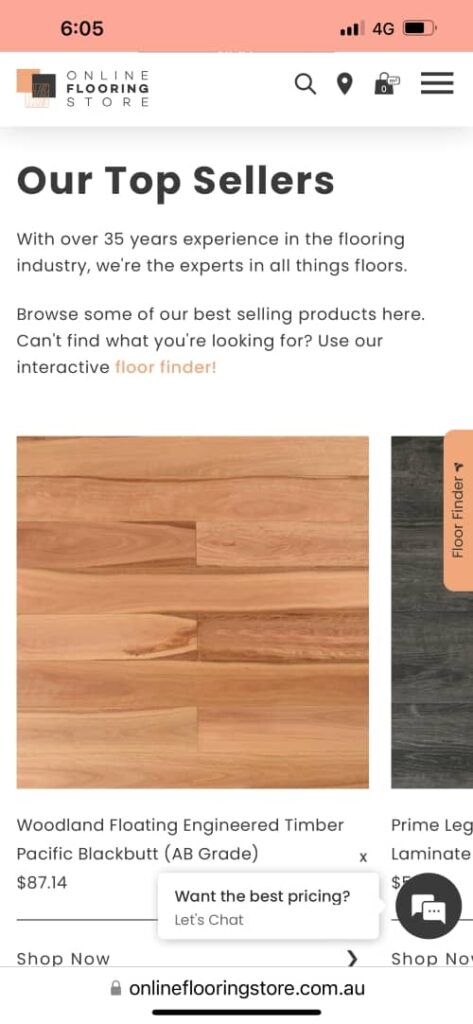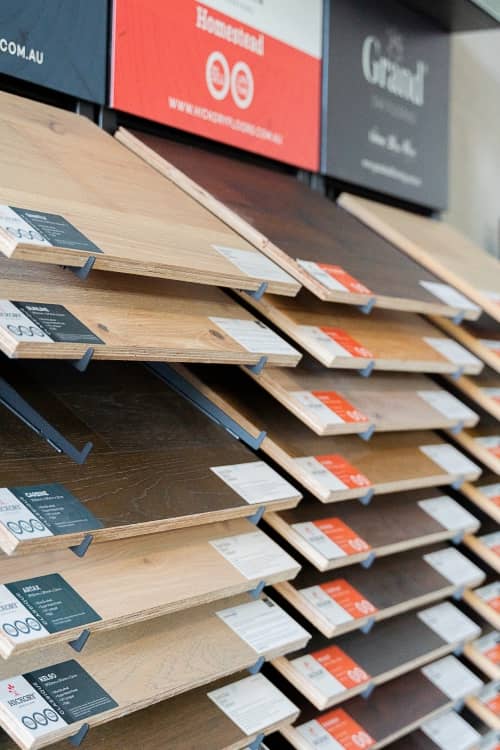“It’s an advertising thing“, as they say. Whether you advertise digitally, via print, with actual flooring samples, or a combination of everything, no matter how hard you try, there will always be minor differences compared to a final product. And yes, you guessed, there are various reasons for this.
This blog post identifies possible differences in advertising products vs. the real thing and, as a potential customer, how to have realistic expectations about what can occur.
Our goal is to help you dramatically increase the likelihood of receiving the right product the first time around. But don’t stress because, in most cases, people do!
Overview:
- How Do Colour and Pattern Variations Occur?
- Synthetic Flooring Colour and Pattern Variations
- Timber Flooring Variations for a Natural Product
- Different Advertising Mediums for Products
How Do Colour and Pattern Variations Occur?
Every home and situation is different, but flooring outcomes can be more predictable if you know what to be wary of.
What’s the issue? And how do we fix it?
In rare occurrences, customers will see a colour online or in print, and what arrives at their home isn’t exactly what they envisioned based on the information they saw. No, they aren’t going crazy, either.
This can be for several reasons. First, let us break flooring into two main types:
Synthetic Flooring
Here we are referring to Vinyl Plank, Laminate and Hybrid Floors.
Sometimes between batches, a few things can cause colour & shade variation:
The Ink Used to Print on the Product
Sometimes, for instance, there could be a slightly higher level of one colour vs another, which colours your product’s picture film or ‘Decor’ as it is also known. Generally speaking, this is a rare occurrence but can occur if a company changes ink or film suppliers. On top of this, a print that uses more colours will appear more vibrant than a print that uses less.
For Example, A 7-colour print will look more vibrant than a 3-colour print, which will look significantly flatter. Typically the more expensive a product is, the more colours its print will have.
A Company Changes a Colour, Film, Pattern or Pattern Sequence
Sometimes a supplier will change a decor simply because they find an image that they think is better. However, they do not always change the name of the colour, especially in the case of Australian Species prints. You may be looking online at the older decor when there is a new print in the market.
The Sheen Level of the Wear Layer Can Affect the Colour Significantly
Laminate, hybrid and vinyl are all made with a process called “hot pressing”. A metal plate melts a timber grain into the product’s wear layer, creating a wood-like texture on the surface of the wear layer. Plates wear out over time and become flattered. A flatter plate will give the appearance of a higher gloss level on the product. Full gloss products are made using a completely flat plate.

Expert Insights From Clem Sturgess
20+ years' experience in hard flooring
The sample customers have picked from the store with natural products may not match what turns up on their floor. This is often due to oxidization; the sample has been around a long time and has oxidized, and the product on their doorstep has not. It can be difficult for customers to understand this, and they must have faith that things will turn out. Taking the time to explain things is so important for their satisfaction. Hostility can arise from misunderstanding. An easy way to get the point across is to ask them if they have had or seen the impact a rug can have that's left on new flooring for a while when removed.
Sun Exposure & Fading
If a Decor is not UV-stabilised, it will deteriorate over time, depending on the amount of sun exposure it experiences. Over time greys can become greener, browns tend to become whiter, and the picture generally lightens. The Australian sun can bleach colour significantly.
To avoid this: Window coverings are essential. To our knowledge, no supplier will guarantee against sun fade bleaching. Still, using a higher-end product with UV stabilization on the decor will dramatically slow the process of fading.
Wear and Tear
Over time, wear and tear won’t affect film colour but will impact the wear layer, especially in stairs and hallways where high foot traffic occurs through the centre.
Side note: Texture and plate embossing vary dramatically across brands and ranges regardless of what they are used to make. For instance, Signature Quatro Hybrid has a very light & small emboss, creating more of a matt effect and not a timber grain. On the other hand, Clever Choice Hybrid Flooring has a much heavier timber grain pattern embossed into it.
Pattern Repeats
With all synthetic products, the number of pattern repeats will depend on the size & diameter of the roller that prints the Decor.
For example: when Laminate Flooring first entered the market in long board format, people were unaware of the diameter of the rollers that are used to print the Decors. Some suppliers, either to save cost or expedite the release of a new product into the market, would use existing rollers of a 1.2m diameter to print decors for boards that were 1.8m long or greater! This means that you would have the same pattern repeating itself on the same board.
Better suppliers, though, invest in Print Rollers for these large format products. For Example, in my time at Signature Floors, we invested in print rollers that were 2.4m in diameter to print the Australian Species versions of the Aquaplank Laminate which was 2.26m in length.
This allows for a better outcome in a few ways:
- A pattern never repeats itself in any way on the same plank
- Where the Roller Diameter is longer than the board length, it ensures that a distinct feature in the print will rarely sit in the same place on a board.
Timber Flooring
Whether it’s Engineered Timber, Solid Timber or Bamboo any natural product is subject to colour variation as nature does not like to repeat itself.
The way natural colour variation affects your product will depend upon whether your product is:
- A Natural, Raw wood, or
- Natural Woods with a colour stain
Typically oak, hickory and bamboo flooring have a natural, unstained version, but they will also all have coloured & stained versions. Australian species are typically uncoloured and left natural, as they have great features and natural colour.
The following can be common variations with timber flooring:
You Are Dealing With a Natural Product
You can slice a tree and notice the colour variation between the growth rings within the same tree. This is often seen as ‘Swirls’ or Oblong shapes in the grain and is visible through their colour changes. This is unavoidable and is a part of the natural beauty of timber. Typically in products such as oak, the difference is not as pronounced, which is often one of the reasons why Oak is coloured: Firstly, because on its own it is not as characterful as Australian Species timbers, but secondly, it is a great canvas to paint on.
Australian Eucalypts tend to have a lot more ‘life’ in their appearance than many other timber species currently used for flooring in Australia. Timbers such as Blackbutts and Bluegums can and will vary but are generally quite consistent. Spotted Gum, however, will differ dramatically, from blonde through to chocolate, with hints of green and red along the way!
Our Tip: Think in terms of buying a species, not a colour. Each species has a life of its own; every tree will be different, and it is impossible to guarantee that the colour you have seen in the sample is the same as the colour that will arrive at your home.
Stained Timbers
Typically the lighter the stain is, the more natural colour variation you will be able to see. Timber stains are colours that are added to the timber. Think of them in terms of holding coloured cellophane over a piece of timber. A light stain will show more of the actual character of the timber and colour variation than a darker one, as with darker stains, the product’s colour tends to appear far more uniform the darker the stain becomes. This is because the stain has a greater colour pigmentation which tends to override the natural colour of the timber.
Oxidization (see below) still occurs and changes the colour of the timber underneath the colour stain. This will still be very pronounced with a light colour stain, but far less so with a dark stain. Medium stains fall somewhere in between depending on the depth of the colour stain itself.
Oxidization
Oxidization occurs when a product is exposed to air and sunlight. A common occurrence is that people lay a new timber floor in a lighted area and lay a rug over an area of the new floor. At some stage, they will move the rug, and become panicked when they see that underneath where the rug was is now a different colour from the rest of the floor.
This is because the part of the floor that was exposed to the light has oxidized, but the part that was covered by the rug has not done so to the same level. However, there is no cause for alarm. Simply remove the rug and give the floor time to oxidise. Timber will oxidise to a point and then no more, so the discoloured patch will catch up to the rest of the floor.
An issue can occur when people try to match older Oxidised timber to newer timber. In some cases (Blue Gum for instance,) they can start life pale and change to quite a dark colour. The reality is that over time the new timber will oxidise properly and probably better match the existing wood. As Timber Oxidises, it typically becomes richer in colour and more vibrant. Remember with natural timber; you are buying a species and not a colour.
The bottom line: With all-natural timber products, you can never guarantee what the colour will truly be like. A sample is only an indication and not an exact representation. Your Spotted Gum floor may look very different to your neighbour’s. For example, the Spotted Gum timber that was coming through ten years ago was very caramel with chocolates and blondes in the mix. What has been coming through in the last few years has often had a lot more greens and reds within the timber and can look quite different.
Side note: When you are watching a TV program like The Block, it is best to view this as ‘For entertainment purposes only. At a previous company I worked for, we supplied 50m of Spotted Gum for a Home Renovation show. What the viewer got to see was the contestant’s van driving into the warehouse, people shaking hands and then the happy contestants driving away with 50m of product quickly, safely and effectively, loaded on board their vehicle.
What the viewer did not get to see, however, was the hours spent by the contestants looking through 200m of the product to select the best and choicest pieces of the timber for the 50m of product that the unsuspecting viewer got to see on the TV. Unless you also are starring in a national TV show, there is not a supplier in the country that will allow you to do this. Sorry.
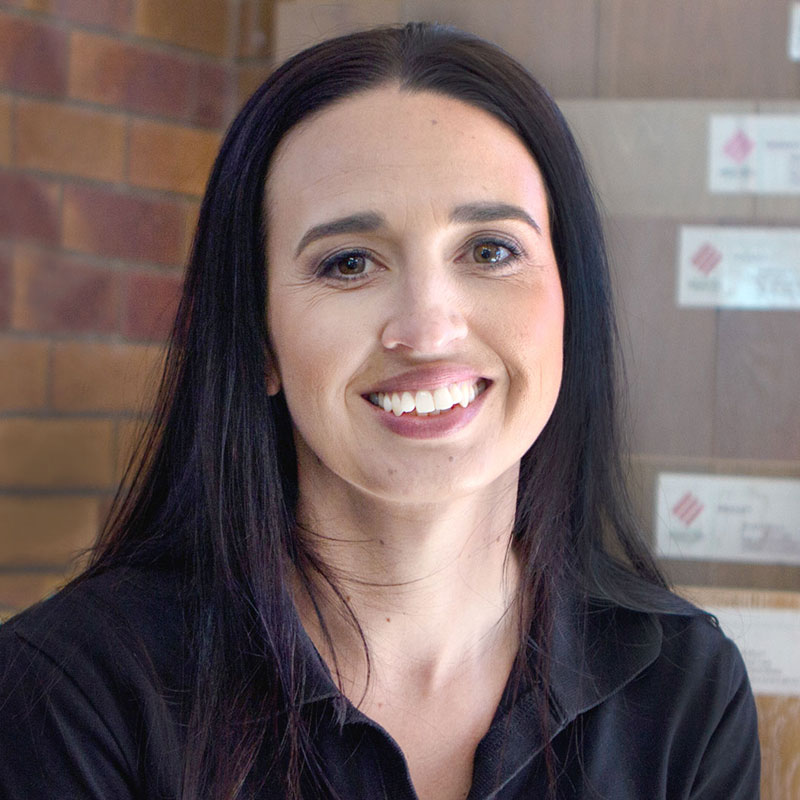
Expert Insights From Raquel Billett
Interior Décor Expert
We quoted a customer online for a few different engineered timber flooring options. The customer came to our showroom to view samples. The goal was for him to match the existing flooring he already had in his home. In the end, he chose a product based on a website image. On delivery, the product was what he ordered but was lighter than the expected website image. He sent us a photo of his two floors to illustrate the difference. Although there were some anticipated changes with the new flooring over time, we liaised with him and the supplier to find a closer match to his floor.
The initial product was delivered back, and our supplier from Cleaver Choice assisted with finding a product that would keep our customer's happy long term. A sample of a darker product was taken home to be reviewed by the customer, and it was decided that this would be a better option for him. We organised a quick picked-up of the product for him as his laying was starting early next week. We were thrilled to receive a 5-star review for our service.
We strive to get it right the first time, as it is a headache for customers and all parties to change options, but at the end of the day, we want them to be happy and informed about their flooring choice. That's just how we do business.
Location the Timber is Grown
As any good sniper will say: Location, Location, Location! Let’s use Spotted Gum as an example. The 2 best known Spotted Gum sub-species that are used for flooring are the more popular NSW Spotted Gum (Corymbia Maculata,) and QLD Spotted Gum (Corymbia Citriodora,) which is commonly known as “Lemon Scented Gum’, or less popularly as ‘Blue Spotted Gum’.
Sometimes suppliers will mix these due to certain amounts of feedstock being available. As people know the name ‘Spotted Gum’ sometimes ‘Lemon Scented Gum’ is mixed into or substituted for the product you know as Spotted Gum. While this is not technically a deception, what people think of as Spotted Gum is typically NSW Spotted Gum. QLD Spotted Gum though is still a Spotted Gum, just not the Spotted Gum you are thinking of. So this can sometimes be a blurry line.
Australia is a vast continent in terms of land mass, climate, soil, water, and air conditions. These factors as well as seasonal weather changes, can significantly impact how timber grows in different areas.
For Example: What if a bird in Sydney is enjoying lunch, nibbling on some Blue Gum seeds, suddenly feels the onset of winter, and decides to head north and spend winter in sunny Queensland? Who can blame him? As he heads north, though, he decides to lighten himself somewhere over Bundaberg and gives those seeds a new home. Technically, the seed is of the same species as the tree from which it was birthed. However, in 20 years the timber that the tree yields are likely to be a lot different to the Mamma tree because of its diet.
Think in terms of a pair of identical twins that are separated by some strange twist of fate. One is given a diet of fresh food and vegetables and works out 3 times a day. The other, however, is given a diet of Pizza, Hamburgers and Soft Drinks with a serious pension for Net Flix. While at one stage of their development, they were essentially the same person, after 20 years, one will be very different from the other.
Blended Species
Now, let’s pick on an iconic Aussie Species, Tasmanian Oak. Everyone knows this and if they can’t tell you what it looks like, they have at least heard of it…Right? Right. But Guess what? There is no such thing. It’s not even an Oak! Mic drop…
What you know as Tasmanian Oak is made up of Mountain Ash, Alpine Ash, Messmate and other Ash species, which are all similar to Eucalypts, but because of the evolution we outlined above, they are all distinct sub-species. However, they are so closely related that most people can’t tell the difference.
Inevitably customers expect the name ‘Tasmanian Oak’ but have no idea of what’s under the bark. Perhaps they are ‘barking’ up the wrong tree (pun intended). One batch could be predominantly Messmate; another could be predominately Alpine ash. How would you know?
One supplier some years ago harvested a Blackbutt forest but had found, after the trees were logged, that some of the trees that had not been planted in the forest and made their way there through other means were not Blackbutts, but similar species that looked very similar. Rather than try to separate the Blackbutts from the Non-Blackbutts, the supplier decided instead to use the name ‘Southern Eucalypt’ for the batch.
Because Nature is Nature, she will do whatever she wants, no matter how hard we try to label her and put her in a box. Rather than vainly attempting to force her to comply, suppliers often find it easier to give several species a collective name and be done with it!
Note to look for product links on the website with colours.
Advertising Mediums
How and where product illustrations and samples are displayed can quite often differ from the physical product. For the reasons above, both natural and artificial flooring products are affected by this. Advertising mediums can and do add to possible discrepancies between an image you see and real life. Among other things, computers display colour differently, the light in which an image is taken, and the difference in ink colours can play havoc with the decision-making process.
Without going into technical detail, we list a few mediums below:
-
Screens
We aren’t screen experts, but it’s not hard to tell that different types of screens display things differently. On top of that, each screen user, whether a monitor, tablet or phone device, has a tremendous amount of choice regarding how they want their screen to display colour. Committed suppliers will leave no stone unturned in terms of being vigilant for digital images to represent the physical product as closely as possible.
Side note: Many online retailers are not aware of this. Suppose you, for instance, take a picture of a flooring area and compress the image into a thumbnail to be displayed online. In that case, the image itself will appear darker because the colour is compressed into a much smaller size of pixels displayed on the screen. In a nutshell, smaller images can be misleading.
-
Printed Product Pictures
There are huge variations in how a product may be represented on paper, plastic, and other signs. Advertisers and marketers exhaust every length to be as close to the real product as possible, but no matter what, there will always be differences.
-
Samples
A less efficient and more expensive route, but it has genuinely earned in place in sales and customer satisfaction. If you are patient enough to wait for samples to arrive, they shouldn’t disappoint in aiding in your decision-making process.
Although often small, the sample is an actual piece of the product itself and accurately represents what the customer will get. On top of the visuals, the potential customer also gets to feel the weight and texture of the product in the comfort of their own home.
In saying that, I can never show you what a full floor will look like: it is a piece of one piece of that floor. However, this is a pretty good guide and the best one can hope for without purchasing an entire product pack.
In collusion, although different advertising mediums may not always 100% accurately depict a product, in most cases, it’s close enough, and we are far better off for utilising them.
Thanks to digital advertising, customers can navigate through many retailers and thousands of products very quickly to find a better flooring product at a reasonable price. The small gap in discrepancy can only improve, as does our technology and how we advertise.


